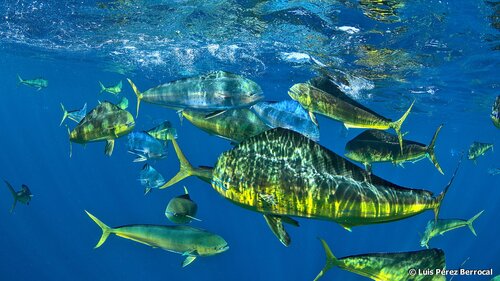
Mahi-mahi
The Bluefin Tuna (Thunnus thynnus, Thunnus orientalis, Thunnus maccoyii) are apex predators of the ocean. They are renowned for their size, speed, and commercial value. These impressive fish are crucial to marine ecosystems and are highly sought after in culinary markets worldwide.
4 5 years
Lifespan
Up to 200 cm
Length
Least Concern
Conservation Status
92 km/h
Swimming speed
Carnivorous, Planktivorous
Diet
Pelagic Migration, Nomadic
Migration
Appearance Overview
The Bluefin Tuna is renowned for its large, streamlined body, built for speed and endurance in the open ocean.
Color
Dark metallic blue above, shimmering silver below
Body Shape
Torpedo-shaped, designed for efficient swimming
Fins
Two dorsal fins, the first depressible; small, yellow finlets running from dorsal and anal fins to tail
Length
Up to 10 feet (3 meters), commonly 6.5 feet (2 meters)
Weight
Average 550 lbs (250 kg), can exceed 1,500 lbs (680 kg)
Diet
Carnivorous, feeding on fish, squid, crustaceans, and occasionally on zooplankton and sessile organisms.
Feeding Behavior
Highly active predator, using speed and agility to hunt; often feeds cooperatively, herding prey.
Social Behavior
Forms large schools, particularly when young; known for long migrations across oceans.
Commercial Relevance
Extremely high value, especially in sushi and sashimi markets; one of the most expensive fish species.
Conservation measures
Subject to international fishing quotas, stock management plans, and monitoring; marine protected areas.
Status
Varies by species: Atlantic Bluefin - Endangered; Pacific Bluefin - Vulnerable; Southern Bluefin - Critically Endangered.
Threats
Overfishing (driven by high demand in sushi markets), bycatch in other fisheries, habitat degradation.
Habitat Distribution
Depth Range
0-1,000 meters (0-3,280 feet), commonly found in surface to mid-waters.
Geographic Range
Atlantic Ocean, Pacific Ocean, Indian Ocean, and Mediterranean Sea.
Preferred Environment
Temperate and subtropical waters; highly migratory, traversing entire oceans.
Reproduction and Life Cycle
Breeding Habits
Spawns in warm waters, with key spawning grounds in the Gulf of Mexico and the Mediterranean Sea.
Development Stages
Eggs hatch into larvae, which develop rapidly in plankton-rich waters; juveniles grow quickly, forming schools.
Fecundity
Females can produce up to 30 million eggs per spawning season, releasing them in batches.
Maturity Age
Varies by species; Atlantic Bluefin typically mature at 4-8 years, Pacific at 3-5 years, and Southern at 8-12 years.
Faqs about Mahi-mahi
Where are Bluefin Tuna found?
Bluefin tuna are found in the Atlantic, Pacific, and Indian Oceans, including the Mediterranean Sea.
How long do Bluefin Tuna live?
Bluefin tuna can live up to 40 years, though this varies by species.
Are Bluefin Tuna warm-blooded?
Yes, they are warm-blooded, which allows them to maintain high body temperatures and swim at fast speeds.
How fast can Bluefin Tuna swim?
Bluefin tuna are among the fastest fish, capable of bursts of speed up to 43 mph (70 km/h).
What is the biggest threat to Bluefin Tuna?
The main threat is overfishing due to their high value in the sushi market.
Where and how do Bluefin Tuna reproduce?
They spawn in specific areas like the Gulf of Mexico and the Mediterranean Sea, with females releasing millions of eggs.
Copyright @ Nature Style Limited. All Rights Reserved.
 English
English